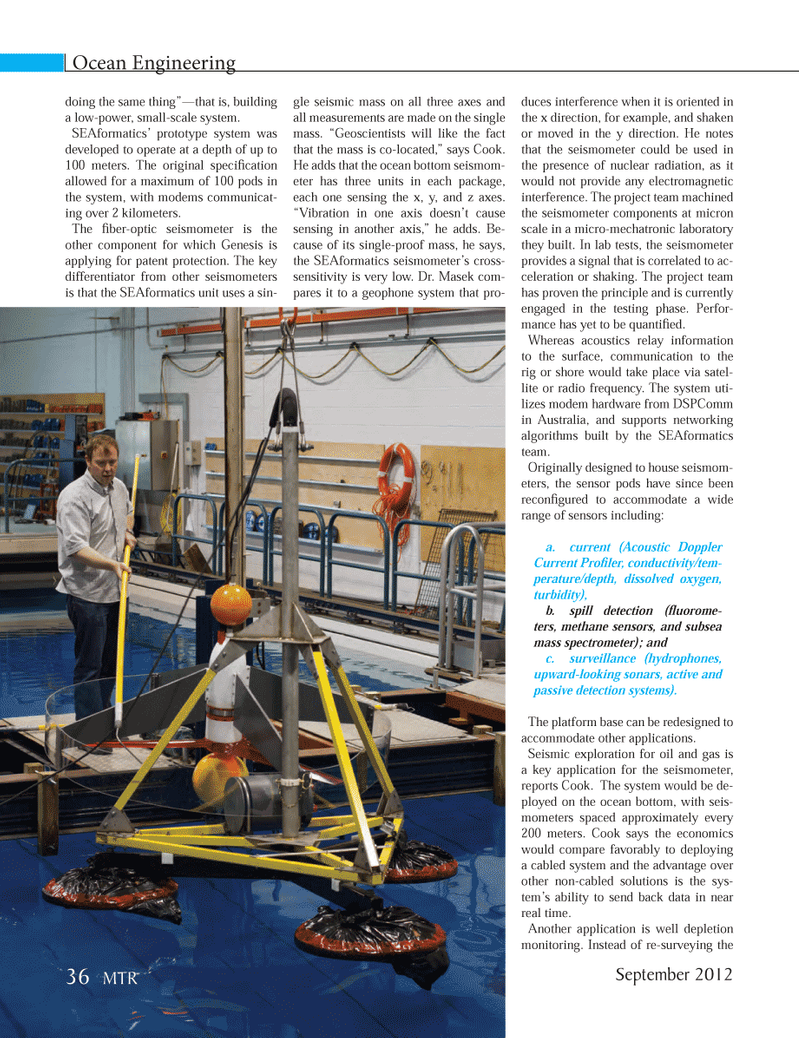
Page 36: of Marine Technology Magazine (September 2012)
Subsea Defense: Protecting Port & Subsea
Read this page in Pdf, Flash or Html5 edition of September 2012 Marine Technology Magazine
doing the same thing??that is, building a low-power, small-scale system. SEAformatics? prototype system was developed to operate at a depth of up to 100 meters. The original speci cation allowed for a maximum of 100 pods in the system, with modems communicat-ing over 2 kilometers. The ber-optic seismometer is the other component for which Genesis is applying for patent protection. The key differentiator from other seismometers is that the SEAformatics unit uses a sin-gle seismic mass on all three axes and all measurements are made on the single mass. ?Geoscientists will like the fact that the mass is co-located,? says Cook. He adds that the ocean bottom seismom-eter has three units in each package, each one sensing the x, y, and z axes. ?Vibration in one axis doesn?t cause sensing in another axis,? he adds. Be- cause of its single-proof mass, he says, the SEAformatics seismometer?s cross- sensitivity is very low. Dr. Masek com- pares it to a geophone system that pro-duces interference when it is oriented in the x direction, for example, and shaken or moved in the y direction. He notes that the seismometer could be used in the presence of nuclear radiation, as it would not provide any electromagnetic interference. The project team machined the seismometer components at micron scale in a micro-mechatronic laboratory they built. In lab tests, the seismometer provides a signal that is correlated to ac- celeration or shaking. The project team has proven the principle and is currently engaged in the testing phase. Perfor- mance has yet to be quanti ed. Whereas acoustics relay information to the surface, communication to the rig or shore would take place via satel- lite or radio frequency. The system uti- lizes modem hardware from DSPComm in Australia, and supports networking algorithms built by the SEAformatics team. Originally designed to house seismom-eters, the sensor pods have since been recon gured to accommodate a wide range of sensors including: a. current (Acoustic Doppler Current ProÞ ler, conductivity/tem- perature/depth, dissolved oxygen, turbidity), b. spill detection (ß uorome-ters, methane sensors, and subsea mass spectrometer); and c. surveillance (hydrophones, upward-looking sonars, active and passive detection systems). The platform base can be redesigned to accommodate other applications. Seismic exploration for oil and gas is a key application for the seismometer, reports Cook. The system would be de- ployed on the ocean bottom, with seis- mometers spaced approximately every 200 meters. Cook says the economics would compare favorably to deploying a cabled system and the advantage over other non-cabled solutions is the sys-tem?s ability to send back data in near real time. Another application is well depletion monitoring. Instead of re-surveying the Ocean Engineering September 201236 MTRMTR #7 (34-49).indd 36MTR #7 (34-49).indd 369/10/2012 9:57:23 AM9/10/2012 9:57:23 AM

 35
35

 37
37
